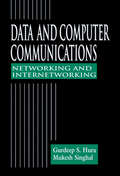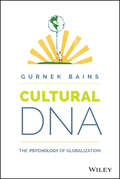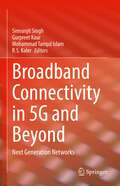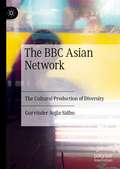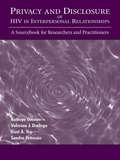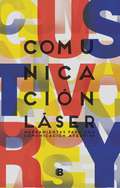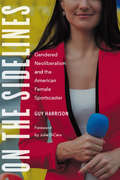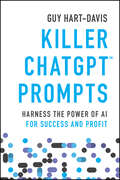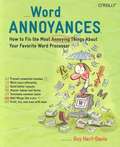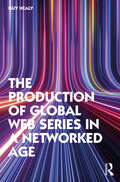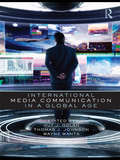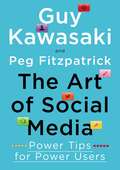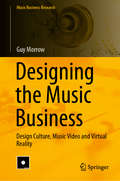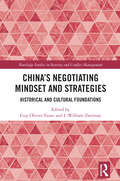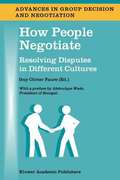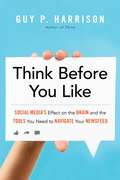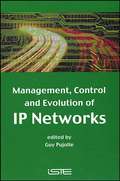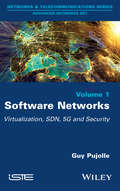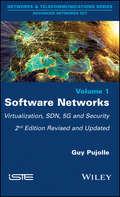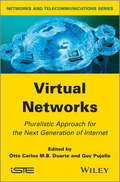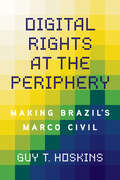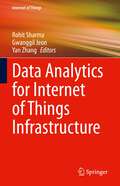- Table View
- List View
Data and Computer Communications: Networking and Internetworking
by Gurdeep S. Hura Mukesh SinghalThe protocols and standards for networking are numerous and complex. Multivendor internetworking, crucial to present day users, requires a grasp of these protocols and standards. Data and Computer Communications: Networking and Internetworking, a comprehensive text/reference, brings clarity to all of the complex issues involved in networking activi
Cultural DNA
by Gurnek BainsDevelop deeper cultural intelligence to thrive in a globalized world. Cultural DNA is a thought provoking book for successful engagement with cultures around the world. Written by Gurnek Bains, founder and chairman of a global business psychology consultancy, this book guides leaders through the essential soft skills required to get under the skin and engage an increasingly connected world. Presenting ground breaking original research and the latest evidence from neuroscience, behavioral genetics, and psychology, the deepest instincts of eight key global cultures are dissected. Readers will understand the psychological themes at play in regions such as the U.S., Latin America, Europe, China, India, the Middle East, Sub-Saharan Africa and Australia. Additionally, an extensive database of 30,000 leaders provides insights to inform the reader. The book addresses questions such as: What are the challenges for leaders from different regions as they move into onto the global stage? Why are Americans so positive? Why is China a world leader in manufacturing and India in IT? Why do overseas firms struggle in the U.S. market place? What are the emotional forces driving current events in the Middle East? Each culture has attributes that developed over thousands of years to address unique environmental challenges. This DNA drumbeat from the past reverberates through each society affecting everything. As globalization marches on we can also learn important lessons from the world's distinct societies. Globalization demands that cultures learn to work within each other's needs and expectations, and the right mix of people skills, business acumen, and cultural awareness is key. Business and Political leaders will understand how each regions' cultural DNA influences: Its economic and political institutions. People's underlying consumer psychology. The soft skills needed to lead in that environment. How to best release people's potential. The issues that need to be managed to anticipate and solve problems before they arise Every now and again a new book comes along, that is a must read: Malcolm Gladwell's Tipping Point or a Seth Godin's Tribes. Cultural DNA by Gurnek Bains, by virtue of its depth, originality and ambition, is that very book for all global leaders.
Broadband Connectivity in 5G and Beyond: Next Generation Networks
by Gurpreet Kaur Simranjit Singh Mohammad Tariqul Islam R. S. KalerThis book discusses the role of optical networks in 3G, 4G, 5G and beyond. The authors discuss the evolution of the technologies, the research involved, and the applications with respect to optical communication systems. In addition, the book provides in-depth knowledge of broadband connectivity for future generation networks. More focus is given towards the front-, mid- and back- hauling of 5G and beyond. The authors present architecture for broadband connectivity and explain its potential in 5G and beyond applications. This book includes several architectures based on Hybrid Fiber-Wireless; Next Generation Passive Optical Networks Stage 1 and 2; millimeter wave over fiber; sub-THz wave over fiber; millimeter/sub-THz wave over multicore fiber; 6G fronthaul; 6G backhaul; GMPLS networks, and massive MIMO sub-Thz antenna. The contributors provide supplementary material such as simulations, analysis and experiments.
The BBC Asian Network: The Cultural Production of Diversity
by Gurvinder Aujla-SidhuThis ground-breaking new book provides a unique, in-depth analysis of the BBC Asian Network, the BBC’s national ethnic-specific digital radio station in the UK. Gurvinder Aujla-Sidhu offers an insight into the internal production culture at the radio station, revealing the challenges minority ethnic producers faced as they struggled to create a cohesive and distinct 'community of listeners'. Besides the differences of opinion that emerged within the inter-generational British Asian staff over how to address the audience’s needs, the book also reveals the ways in which 'race' is managed by the BBC, and how the culture of managerialism permeates recruitment strategies, music playlists and mother tongue language programmes. In-depth interviews unveil how the BBC's 'gatekeeping' system limits the dissemination of original journalism about British Asian communities, through the marginalisation of the expertise of narratives created by the network's own minority ethnic journalists.
Privacy and Disclosure of Hiv in interpersonal Relationships: A Sourcebook for Researchers and Practitioners (Routledge Communication Series)
by Valerian J. Derlega Kathryn Greene Gust A. Yep Sandra PetronioAs the HIV epidemic enters its third decade, it remains one of the most pressing health issues of our time. Many aspects of the disease remain under-researched and inadequate attention has been given to the implications for the relationships and daily lives of those affected by HIV. Disclosing an HIV diagnosis remains a decision process fraught with difficulty and despite encouraging medical advances, an HIV diagnosis creates significant anxiety and distress about one's health, self-identity, and close relationships. This book provides an overarching view of existing research on privacy and disclosure while bringing together two significant areas: self-disclosure as a communication process and the social/relational consequences of HIV/AIDS. The unifying framework is communication privacy management and the focus of this volume is on private voluntary relational disclosure as opposed to forced or public disclosure. Utilizing numerous interviews with HIV patients and their families, the authors examine disclosure in a variety of social contexts, including relationships with intimate partners, families, friends, health workers, and coworkers. Of note are the examinations of predictors of willingness to disclose HIV infection, the message features of disclosure, and the consequences of both disclosure and non-disclosure. This volume, with its personal exercises and sources of additional information, offers an invaluable resource for individuals living with HIV and their significant others, as well as for professionals in the fields of health communication, social and health psychology, family therapy, clinical and counseling psychology, relationship research, infectious disease, and social service.
UX Writing: Designing User-Centered Content
by Tharon Howard Jason C.K. Tham Gustav VerhulsdonckThis flexible textbook provides an integrated approach to user experience (UX) writing and equips students and practitioners with the essential principles and methods to succeed in writing for UX. The fundamental goal of UX writing is to produce usable and attractive content that boosts user engagement and business growth. This book teaches writers how to create content that helps users perform desired tasks while serving business needs. It is informed by user-centered design, content strategy, artificial intelligence (AI), and digital marketing communication methodologies, along with UX-related practices. By combining writing-as-design and design-as-writing, the book offers a new perspective for technical communication education where UX design and writing are merged to achieve effective and desirable outcomes. Outlining the key principles and theories for writing user-centered content design, this core textbook is fundamental reading for students and early career practitioners in UX, technical communication, digital marketing, and other areas of professional writing.
Oral Presentations in the Composition Course: A Brief Guide
by Matthew Duncan Gustav W. FriedrichThe ideal supplement for any writing class that includes an oral component, Oral Presentations in the Composition Course: A Brief Guide offers students the advice they need to plan, prepare, and present their work effectively. With sections on analyzing audiences, choosing effective language, using visual aids, collaborating on group presentations, and dealing with the fear of public speaking, this booklet offers help for students' most common challenges in developing oral presentations.
Comunicación láser: Herramientas para una comunicación afectiva
by Gustavo ReyPrimer libro del comunicador y periodista Gustavo Rey. Con más de treinta años de experiencia en medios de comunicación, el autor se ha posicionado como uno de los referentes más importantes en el área de comunicación personal y empresarial. Este libro es una caja de herramientas donde el lector podrá encontrar distintas alternativas para conocerse y comunicarse mejor de acuerdo a las diversas situaciones planteadas. Con una narración ágil, dinámica y entretenida Gustavo Rey nos habla desde la experiencia personal y nos transmite los conceptos más importantes de los referentes de la comunicación. Con más de 30 años de experiencia en el área de la comunicación, como periodista, docente, speaker y coach, Gustavo Rey nos presenta Comunicación láser. Herramientas para una comunicación afectiva, un texto ágil, dinámico y lleno de experiencias que nos permitirá adquirir las más diversas herramientas para mejorar nuestra comunicación y a nosotros como personas. Desde cómo preparar una presentación laboral a cómo afrontar una charla de pareja; cómo escuchar y cómo hablar; cómo planificar una clase o simplemente cómo interpretar las emociones y las reacciones de los otros; este libro aporta conocimientos basados en la experiencia personal del autor y presenta los grandes conceptos de la comunicación como disciplina. Al decir del autor, «las mejores prácticas se basan en buenas teorías y nada alimenta más una buena teoría que las prácticas que hacemos». Comunicación láser es un libro interactivo donde el lector entablará una relación con el autor, podrá realizarse preguntas y navegar a través de códigos QR a videos que enriquecerán su experiencia. ¿Cómo comunicarnos de una manera efectiva y afectiva? Esa es la pregunta central que autor y lector intentarán responder.
On the Sidelines: Gendered Neoliberalism and the American Female Sportscaster (Sports, Media, and Society)
by Guy HarrisonWhen sports fans turn on the television or radio today, they undoubtedly find more women on the air than ever before. Nevertheless, women sportscasters are still subjected to gendered and racialized mistreatment in the workplace and online and are largely confined to anchor and sideline reporter positions in coverage of high-profile men&’s sports. In On the Sidelines Guy Harrison weaves in-depth interviews with women sportscasters, focus groups with sports fans, and a collection of media products to argue that gendered neoliberalism—a cluster of exclusionary twenty-first-century feminisms—maintains this status quo. Spinning a cohesive narrative, Harrison shows how sportscasting&’s dependence on gendered neoliberalism broadly places the onus on women for their own success despite systemic sexism and racism. As a result, women in the industry are left to their own devices to navigate double standards, bias in hiring and development for certain on-air positions, harassment, and emotional labor. Through the lens of gendered neoliberalism, On the Sidelines examines each of these challenges and analyzes how they have been reshaped and maintained to construct a narrow portrait of the ideal neoliberal female sportscaster. Consequently, these challenges are taken for granted as &“natural,&” sustaining women&’s marginalization in the sportscasting industry.
Killer ChatGPT Prompts: Harness the Power of AI for Success and Profit
by Guy Hart-DavisUnlock the full capabilities of ChatGPT at work, at home, and in your day-to-day By now, you’ve heard of ChatGPT and its incredible potential. You may even have tried to use it a few times just to see it in action for yourself. But have you ever wondered what ChatGPT is truly capable of? Killer ChatGPT Prompts: Harness the Power of AI for Success and Profit will show you the true power of Large Language Models (LLMs) like ChatGPT. In the book, veteran IT educator and trusted author Guy Hart-Davis shows you the exact prompts he’s discovered to unlock a huge variety of expert business writing, like emails and proposals, data analysis use cases, lesson plans, information exchange scripts, and more! You’ll also find: The perfect prompts for a huge array of job roles, including those in sales and marketing, web development, HR, customer support, and more Use cases for ChatGPT in the home, with your kids, and in your relationship Hundreds more prompts that will make your job, your home life, and your day-to-day so much easierThere’s no doubt about it. LLMs—and ChatGPT—are here to stay. The only question is: Will you have the skills and the wherewithal to unleash its potential in your own life? Killer ChatGPT Prompts can guarantee that you will.
Teach Yourself VISUALLY Word 2019 (Teach Yourself VISUALLY (Tech))
by Guy Hart-DavisMaster one of the most popular word processors ever with this essential, visual reference Teach Yourself VISUALLY: Word 2019 provides readers with a thorough and visual exploration of the 2019 edition of Microsoft Word. Written by the celebrated author of over 100 books on computing, Guy Hart-Davis, Teach Yourself VISUALLY: Word 2019 allows you to quickly get up to speed with one of the most popular word processors on the planet. The book covers all the topics you’ll need to comprehensively master Word 2019, and includes: Full-color, step-by-step instructions showing you how to perform all the essential tasks of Microsoft Word 2019 How to set up and format documents, edit them, and add images and charts How to post documents online for sharing and reviewing and take advantage of all the newest features of Word Newly updated to include the latest features of Microsoft Word, like how to collaborate on documents in real time, draw and write with the digital pen, new accessibility options and the new Resume Assistant, Teach Yourself VISUALLY: Word 2019 belongs on the shelf of anyone who wants to improve their effectiveness with this essential word processor.
Word Annoyances
by Guy Hart-DavisWhen most people think of word processing, they think of Microsoft Word. After all, it has been around for more than 20 years-practically an eternity in computer time. But Word has also provided its users-nearly everyone on the face of the planet-with an endless supply of annoyances. That is, until now. Word Annoyances offers to the point (and often opinionated) solutions to your most vexing editing, formatting, printing, faxing, and scanning problems. It covers everything from installation and templates to tables, columns, and graphics. For example, learn how to stop Word from searching the Web for help, and how to enter the same text easily in multiple parts of a document-and keep it updated automatically. It also provides a gentle introduction to the power of macros so you can slay your annoyances by the truckload. The fixes will work with most versions of Word, including Word 2000, Word 2002 (also known as Word XP), and Word 2003. Among the topics covered: Deal with installation issues, crashes, and slowdowns, and dispose of the Office Assistant-either temporarily or forever. Master templates, numbering, graphics, hyperlinks, tabs, tables, headers, and other everyday annoyances. Tame some of Word's wiliest features, such as Smart Cut and Paste, Click and Type, Mail Merge, AutoCorrect, and AutoText. Printing, Faxing, and Scanning-need we say more? Learn to output and distribute your documents with confidence. Need to work with other Microsoft applications or Macs? You'll find annoyances dealing with Excel, PowerPoint, and Access, as well as a whole chapter just on Mac Word. About the Author Guy Hart-Davis has been using Microsoft Word for more than 15 years, during which time he has seen its capabilities increase steadily and its annoyances increase exponentially. His other books include Word 2000 Developer's Handbook (Sybex) and How to Do Everything with Your iPod and iPod mini (McGraw-Hill). In this book he shares secrets that will quell calm your colleagues, impress your friends, and confound your enemies.
The Production of Global Web Series in a Networked Age
by Guy HealyThis book tells the story of diverse online creators – women, ethnic and racial minorities, queer folk and those from hardscrabble backgrounds – producing low budget, high cultural impact web-series which have disrupted longstanding white male domination of the film and TV industries.Author Guy Healy addresses four burning problems faced by creators in the context of digital disruption (along with potential solutions), namely: the sustainability of monetizing digital content and the rising possibility of middle-class artistic careers; algorithmic volatility; the difficulty of finding people to share jealously guarded industry knowledge as traditional craft-based mentoring and expertise-sharing mechanisms break down; and the lack of diversity and authenticity in high-profile storytelling. It includes nine case studies, five drawn from a second wave of outstanding YouTube-developed talent, transitioning to longer form narrative, most collaborating with established TV producers working across the divide between online and established television culture, and all from under-represented and/or minority backgrounds. The balance are film-school and industry professionals leveraging YouTube in the same way, including two Writers Guild of America new media award-winners. These storytellers leverage their social networks and chase sustainable careers by reaching audiences of subscription video-on-demand platforms and mainstream online broadcast in Australia and North America. The Production of Global Web-Series in a Networked Age is the first longitudinal study of this historic rapprochement between online and television cultures. Four of the cases are in Emmy-winning contexts, and one in an Emmy nominated context.Covering 2005–2021, the book reveals distinctive new forms of screen industry convergence with profound implications for creators’ careers, the screen industry in general, new media theory, and broader cultural and social change. It is essential reading for students, academics and industry professionals working on the production and distribution of web series.
International Media Communication in a Global Age (Routledge Communication Series)
by Wayne Wanta Thomas J. Johnson Guy J. GolanThis volume provides a comprehensive examination of key issues regarding global communication, focusing particularly on international news and strategic communication. It addresses those news factors that influence the newsworthiness of international events, providing a synthesis of both theoretical and practical studies that highlight the complicated nature of the international news selection process. It also deals with international news coverage, presenting research on the cross-national and cross-cultural nature of media coverage of global events, in the interdisciplinary context of research on political communication, war coverage, new technologies and online communication. The work concludes with a focus on global strategic communications: in the age of globalization, global economies and cross-national media ownership, chapters here provide readers with some of the most up-to-date research on international advertising, public relations and other key issues in international communications. With contributions from many of the leading scholars in the field of international media communication research, this collection presents a valuable resource for advancing knowledge and understanding of the complicated international communication phenomenon. It will be of value to upper-level undergraduates and graduate students in mass media and communication programs, and to scholars whose research focuses on global communication research.
The Art of Social Media: Power Tips For Power Users
by Guy Kawasaki Peg FitzpatrickBy now it's clear that whether you're promoting a business, a product, or yourself, social media is near the top of what determines your success or failure. And there are countless pundits, authors, and consultants eager to advise you. But there's no one quite like Guy Kawasaki, the legendary former chief evangelist for Apple and one of the pioneers of business blogging, tweeting, Facebooking, Tumbling, and much, much more. Now Guy has teamed up with Peg Fitzpatrick, who he says is the best social-media person he's ever met, to offer The Art of Social Media--the one essential guide you need to get the most bang for your time, effort, and money. With over one hundred practical tips, tricks, and insights, Guy and Peg present a bottom-up strategy to produce a focused, thorough, and compelling presence on the most popular social-media platforms. They guide you through steps to build your foundation, amass your digital assets, optimize your profile, attract more followers, and effectively integrate social media and blogging. For beginners overwhelmed by too many choices as well as seasoned professionals eager to improve their game, The Art of Social Media is full of tactics that have been proven to work in the real world. Or as Guy puts it, "great stuff, no fluff."
Designing the Music Business: Design Culture, Music Video and Virtual Reality (Music Business Research)
by Guy MorrowThis book addresses the neglect of visual creativities and content, and how these are commercialised in the music industries. While musical and visual creativities drive growth, there is a lack of literature relating to the visual side of the music business, which is significant given that the production of meaning and value within this business occurs across a number of textual sites.Popular music is a multimedia, discursive, fluid, and expansive cultural form that, in addition to the music itself, includes album covers; gig and tour posters; music videos; set, stage, and lighting designs; live concert footage; websites; virtual reality/augmented reality technologies; merchandise designs; and other forms of visual content. As a result, it has become impossible to understand the meaning and value of music without considering its relation to these visual components and to the interrelationships between them. Using design culture theory, participant observation, interviews, case studies, and a visual methodology to explore the topic, this research-based book is a valuable study aid for undergraduate and postgraduate students of subjects including the music business, design, arts management, creative and cultural industries studies, business and management studies, and media and communications.
China's Negotiating Mindset and Strategies: Historical and Cultural Foundations (Routledge Studies in Security and Conflict Management)
by I. William Zartman Guy Olivier FaureThis book analyzes the mindset with which China enters into negotiations, and applies these insights into contemporary arenas of Chinese activity around the world.The volume presents and analyses the historical and cultural foundations of Chinese thinking as used in the practice of present-day negotiation. It begins by addressing the essence of Chinese negotiations and the Chinese mindset, turning to a section that presents the cultural foundations of that mindset and strategy. The concepts of Confucianism, Taoism, Yin-Yang, and Chinese military strategy are highlighted. The cases of the Belt-and-Road Initiative and the South and East China Seas are examined to show the application of these concepts, with one addressing business and economic negotiations and the other examining cases of negotiation in geopolitics. Finally, a synthesis of what has been learned is presented, which will contribute to negotiation theory and ultimately will help Western practitioners contemplating negotiation with Chinese diplomats and businesses, as well as being a basis for policy analysts’ understanding of Chinese practices in international relations.This book will be of much interest to students of international negotiation, foreign policy, business studies, and international relations, as well as practitioners and policymakers.
How People Negotiate: Resolving Disputes In Different Cultures (Advances In Group Decision And Negotiation #1)
by Guy Olivier FaureHow People Negotiate brings together a set of negotiation stories, accompanied by an integrative overview. This volume provides cases and theoretical elaboration and includes a comprehensive overview of research on negotiation. Some negotiation stories are exotic and strange: they come from a large number of countries, ranging from China, to African Countries, to the Ancient Middle East. Others are drawn from Western settings such as France, Germany, and USA. The negotiations described take various forms: negotiating with oneself, negotiating one's own way through bicycle traffic or animals appearing to negotiate with each other. The stories begin with Abraham negotiating with the Lord about the fate of Sodom, the first-ever recorded account of negotiations. The negotiations in this volume present something new and unusual. They are catchy, intriguing, exciting, intellectually challenging and original. They give us a new perspective on negotiating, tell us something about the world we live in, and - by means of a worthwhile detour - they teach us about ourselves.
Think Before You Like: Social Media's Effect on the Brain and the Tools You Need to Navigate Your Newsfeed
by Guy P. HarrisonAt a time when the news cycle turns on a tweet, journalism gets confused with opinion, and facts are treated as negotiable information, applying critical thinking skills to your social media consumption is more important than ever.Guy P. Harrison, an upbeat advocate of scientific literacy and positive skepticism, demonstrates how critical thinking can enhance the benefits of social media while giving users the skills to guard against its dangers.Social media has more than two billion users and continues to grow. Its widespread appeal as a means of staying in touch with friends and keeping up with daily news masks some serious pitfalls-- misinformation, pseudoscience, fraud, propaganda, and irrational beliefs, for example, presented in an attractive, easy-to-share form. This book will teach you how to resist the psychological and behavioral manipulation of social media and avoid the mistakes that millions have already made and now regret.Harrison presents scientific studies that show why your subconscious mind loves social media and how that can work against your ability to critically evaluate information. Among other things, social media reinforces your biases, clouds your judgment with images that leave a false impression, and fills your brain with anecdotes that become cheap substitutes for objective data. The very nature of the technology keeps you in a bubble; by tracking your preferences it sends only filtered newsfeeds, so that you rarely see anything that might challenge your set notions. Harrison explores the implications of having digital "friends" and the effects on mood, self-esteem, and the cultivation of friendship in the real world. He discusses how social media affects attention spans and the ability to consider issues in depth. And he suggests ways to protect yourself against privacy invasion, cyberstalking, biased misinformation, catfishing, trolls, misuse of photos, and the confusion over fake news versus credible journalism.
Management, Control and Evolution of IP Networks (Wiley-iste Ser.)
by Guy PujolleInternet Protocol (IP) networks have, for a number of years, provided the basis for modern communication channels. However, the control and management of these networks needs to be extended so that the required Quality of Service can be achieved. Information about new generations of IP networks is given, covering the future of pervasive networks (that is, networks that arealways present), Wi-Fi, the control of mobility and improved Quality of Service, sensor networks, inter-vehicle communication and optical networks.
Software Networks
by Guy PujolleThe goal of this book is to describe new concepts for Internet next generation. This architecture is based on virtual networking using Cloud and datacenters facilities. Main problems concern 1) the placement of virtual resources for opening a new network on the fly, and 2) the urbanisation of virtual resource implemented on physical network equipment. This architecture deals with mechanisms capable of controlling automatically the placement of all virtual resources within the physical network. In this book, we describe how to create and delete virtual networks on the fly. Indeed, the system is able to create any new network with any kind of resource (e.g., virtual switch, virtual routers, virtual LSRs, virtual optical path, virtual firewall, virtual SIP-based servers, virtual devices, virtual servers, virtual access points, and so on). We will show how this architecture is compatible with new advances in SDN (Software Defined Networking), new high-speed transport protocol like TRILL (Transparent Interconnection of Lots of Links) and LISP (Locator/Identifier Separation Protocol), NGN, IMS, Wi-Fi new generation, and 4G/5G networks. Finally, we introduce the Cloud of security and the virtualisation of secure elements (smartcard) that should definitely transform how to secure the Internet.
Software Networks: Virtualization, SDN, 5G, and Security
by Guy PujolleSoftware Networks describe new concepts for the Internet's next generation. This architecture is based on virtual networking using Cloud and datacenter facilities. The main problems to be dealt with are the placement of virtual resources for opening a new network on the fly, and the urbanization of virtual resources implemented on physical network equipment. The digital architecture also deals with mechanisms capable of automatically controlling the placement of all virtual resources within the physical network. This book describes how to create and delete virtual networks on the fly. Indeed, the system is able to create any new network with any kind of virtual resource (e.g. switches, routers, LSRs, optical paths, firewalls, SIP-based servers, devices, servers, access points, etc.). Software Networks shows how this architecture is compatible with new advances in SDN (Software Defined Networking), new high-speed transport protocols such as TRILL (Transparent Interconnection of Lots of Links) and LISP (Locator/Identifier Separation Protocol), NGN, IMS, new generation Wi-Fi, and 4G/5G networks. Finally, the author introduces Clouds of security and the virtualization of secure elements (smartcards) that could certainly transform how to secure the Internet. For this second edition, the author addresses in five new chapters the importance of open source software for networks, mobile edge computing, fog networking, tactile internet – a network environment allowing remote access, and security – the use of Cloud of security, secure elements and the emergence of the blockchain.
Virtual Networks: Pluralistic Approach for the Next Generation of Internet
by Guy Pujolle Otto Carlos M.B. DuarteThe first chapter of this title concerns virtualization techniques that allow sharing computational resources basically, slicing a real computational environment into virtual computational environments that are isolated from one another. The Xen and OpenFlow virtualization platforms are then presented in Chapter 2 and a performance analysis of both is provided. This chapter also defines the primitives that the network virtualization infrastructure must provide for allowing the piloting plane to manage virtual network elements. Following this, interfaces for system management of the two platforms are proposed in Chapter 3. To control and manage virtual network elements, five primitives that the network virtualization infrastructure must provide are defined: instantiate, delete, migrate, monitor and set. The book then moves on to survey existing control algorithms for virtual networking. It also describes the main challenges for packet forwarding using Xen as a virtualization tool and describes, in more detail, a proposal for local control of virtual networks. Within each physical node, this proposal guarantees the service level acquired by each virtual network, even in the presence of misbehaving virtual networks. Contents 1. Virtualization, Luís Henrique M.K. Costa. 2. Virtual Network Interfaces, Miguel Elias M. Campista. 3. Performance Improvement and Control of Virtual Network Elements, Igor M. Moraes. 4. State of the Art in Context-Aware Technologies, Edmundo R.M. Madeira and Guy Pujolle. 5. Providing Isolation and Quality-of-Service to Virtual Networks, Miguel Elias M. Campista. 6. Piloting System, Edmundo R.M. Madeira and Nelson Luis S. Da Fonseca. 7. Management and Control: The Situated View, Otto Carlos M.B. Duarte. 8. System Architecture Design, Otto Carlos M.B. Duarte. About the Authors Otto Carlos M.B. Duarte is Full Professor at Universidade Federal do Rio de Janeiro in Brazil, where he has worked since 1978. His research interests include mobile communications, security, multicast, and QoS guarantees. Guy Pujolle is currently Professor at University Pierre and Marie Curie (Paris VI) in France and a member of the Scientific Advisory Board of Orange/France Telecom Group. He has published widely in the area of computer systems modeling and performance, queuing theory, high-speed networks, intelligence in networking, wireless networks, and Post-IP networks, including 19 influential texts and monographs in these areas.
Digital Rights at the Periphery: Making Brazil's Marco Civil (Geopolitics of Information)
by Guy T. HoskinsSigned into law in 2014, the Marco Civil da Internet (Brazilian Civil Rights Framework for the Internet) appeared to offer pioneering legislation for a digital bill of rights that addressed issues like network neutrality and privacy. Guy T. Hoskins chronicles the Marco Civil’s development and its failure to confront the greatest concentration of power in the digital age: informational capitalism. Combining interviews with discourse and political-economic analysis, Hoskins reveals why the legislation fell short while examining the implications of its emergence in Brazil, which remains on the margins of the global system of informational capitalism. Hoskins places collectivist and public service principles at the core of any framework’s effectiveness. He also shows why we must create systems sensitive to the sociocultural and political-economic contexts that will shape digital rights and their usefulness. Compelling and contrarian, Digital Rights at the Periphery looks at communications policy and internet governance in the Global South and the lessons they provide for the rest of the world.
Data Analytics for Internet of Things Infrastructure (Internet of Things)
by Rohit Sharma Yan Zhang Gwanggil JeonThis book provides techniques for the deployment of semantic technologies in data analysis along with the latest applications across the field such as Internet of Things (IoT). The authors focus on the use of the IoT and big data in business intelligence, data management, Hadoop, machine learning, cloud, smart cities, etc. They discuss how the generation of big data by IoT has ruptured the existing data processing capacity of IoT and recommends the adoption of data analytics to strengthen solutions. The book addresses the challenges in designing the web based IoT system, provides a comparative analysis of different advanced approaches in industries, and contains an analysis of databases to provide expert systems. The book aims to bring together leading academic scientists, researchers, and research scholars to exchange and share their experiences and research results on all aspects of IoT and big data analytics.
